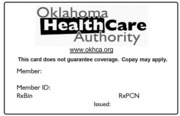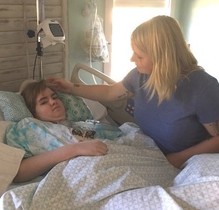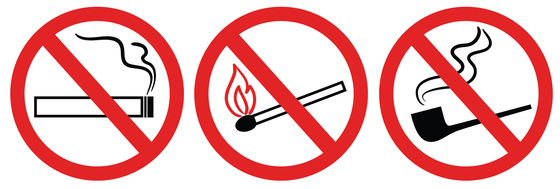|
Fall 2017, Vol 1

 By now, you are probably aware that the Oklahoma Supreme Court ruled the $1.50 per pack smoking cessation fee as unconstitutional. This action affects the Oklahoma Health Care Authority (OHCA) in two ways.
First, research shows a correlation between price increases for cigarettes and decreased smoking rates. Decreased smoking rates would likely have a positive effect on the agency’s budget in the future.
Second and more immediate, the OHCA would have received $70 million of the fee’s total appropriation towards our state fiscal year (SFY) 2018 base appropriation. This ruling creates a considerable hole in our budget. If the $70 million isn’t replaced, the agency will also lose about $105 million in federal matching funds. The OHCA’s total state appropriation for SFY18 is $1,025,516,034. Our total budget for SFY18 is $5,664,319,830.
Furthermore, the state’s SFY18 budget has a total shortfall of $215 million as a result of the Supreme Court ruling. We are working closely with state leadership to determine how this deficit will be handled.
On September 6, Gov. Mary Fallin issued a statement announcing plans to call a special session beginning September 25, 2017, with the intent to adjust the current fiscal year budget. As the OHCA awaits the outcome of this special session, we continue to work to avoid provider rate reductions, if at all possible.
|
 Another outstanding funding issue that the agency is watching is the reauthorization for funding of the Children’s Health Insurance Program (CHIP). Within our program, CHIP is operated as part of SoonerCare. Should enhanced CHIP funding not be reauthorized, the agency stands to lose about $49 million in federal funds in SFY18.
To file a balanced budget and accommodate for this potential loss in federal funding, the agency announced plans to push two claim runs into July 2018. This will help to ensure that the SoonerCare program is able to operate through SFY18, which ends June 30.
Positive news regarding the CHIP program came out of Washington Sept. 12 when it was announced that the Senate Finance Committee had agreed to a proposed five-year funding extension for the program. The OHCA will continue to monitor the situation closely.
Your continued service to our SoonerCare and Insure Oklahoma members is more important than ever. We at the OHCA appreciate your patience as we work through these circumstances.
Back to top
|

 Effective November 1, 2017, the OHCA will no longer be mailing plastic member ID cards. This is part of our continuing efforts to be fiscally responsible and reduce paper usage.
This change applies to both SoonerCare and Insure Oklahoma members, as well as children who receive SoonerCare dental benefits under a parent’s Insure Oklahoma Employer-Sponsored Insurance plan.
However, if a physical member ID card is needed, members have the ability to print cards from their Member Portal.
As an added convenience, providers now have the option to print ID cards from the SoonerCare Provider Portal. To print a member ID card from the Portal, simply:
- Select the Eligibility Tab.
- Check the member’s eligibility.
- Select "Display Member ID Card."
The button will not display if the member does not currently have eligibility.
If you have any questions, please call the OHCA Provider Helpline at 1-800-522-0114.
Back to top
|

 It’s time for the fall
2017 SoonerCare Provider Training Workshops, and we’re getting down to
business!
This session covers:
patient-centered medical home (PCMH) updates; understanding and correcting
claim denials; documentation; Federal and State Authorities policy; provider
enrollment; SoonerCare wellness benefits (tobacco cessation); and Vaccine for
Children (VFC) provider training.
Full course descriptions
and registration details are available on the provider training page of our website:
www.okhca.org/xcourses.aspx.
OHCA highly recommends
that all providers attend a workshop. We hope to see you at one of the
following trainings:
-
Lawton September
28
-
Durant October
5
-
Tulsa October
11 - 12
-
OKC October
25 - 26
-
Guymon* November
1
SoonerCare Provider
Training Workshops are hosted by OHCA and DXC Technology (formerly Hewlett
Packard Enterprise).
*Only PCMH, claim denials, and documentation classes available.
Back to top
|

The OHCA is trying to address the shortage of nurses working in the private duty nursing (PDN) field. The agency is proposing to increase the rates paid to PDN providers to $30.20 per hour from $25.20 per hour. It would be the first rate increase for the provider type since January 2007.
“Currently, there are not enough providers to fulfill the demand for these services,” said OHCA CEO Becky Pasternik-Ikard. “We believe the rate increase will enable providers to hire more nurses and thus have a positive impact on access to care.”
The proposed rate change which would go into effect Oct. 1. 2017, is projected to be budget neutral for the agency.
The OHCA board will vote on the PDN rate increase at their Sept. 27 board meeting.
Read more here.
 |
|
Nicole Westby is one of two nurses who provide private duty nursing services to SoonerCare member Avery Anderson at her home in Ada, Okla. |
Back to top

 Contracts for the following providers expire soon. We encourage you to start the re-enrollment process as soon as possible through the secure OHCA Provider Portal.
Contracts expiring Sept. 30, 2017:
- Dentist
- Genetic counselor
- Independent diagnostic testing facility
- Independent lab
- Lactation consultant
- Maternal and infant health licensed clinical social worker
- Room & board
Contracts expiring Nov. 30, 2017:
- Certified nurse midwife
- Certified nurse practitioner
- Certified registered nurse anesthetist
- Certified nurse specialist
- Group
- OSU and OU physicians
- Rural health clinics
OHCA appreciates your attention to this matter and looks forward to your continued partnership.
|
 |
|
ATTENTION ALL PROVIDERS!
OHCA would like to remind you that all required documents for contracts must be uploaded and received by OHCA no more than 30 days from the date of submitting your contract. This completion requirement applies to new contracts as well as renewals.
Back to top
|

Immunization recommendations for pregnant women
Flu season is just around the corner and the OHCA recognizes the critical role of immunizations in protecting the health of pregnant women and their newborns. We encourage SoonerCare providers to administer vaccines as recommended by the Advisory Committee on Immunization Practices (ACIP). ACIP recommends the following vaccinations for pregnant women:
- Trivalent inactivated influenza (TIV) vaccine;
- Tetanus/diphtheria/acellular pertussis (Tdap), given between 27 to 36 weeks of pregnancy; and
- Vaccines for hepatitis A virus, hepatitis B virus, pneumococcus, and meningococcus (which may be administered in the third trimester if the member is at risk for these diseases by virtue of lifestyle, travel or occupation).
Providers administering vaccines to pregnant SoonerCare members will be reimbursed for the vaccine according to the fee schedule.
Pregnant women can receive vaccinations from their obstetrician/gynecologist or primary care provider (PCP). OHCA encourages obstetricians to coordinate with the member's PCP to ensure that appropriate immunizations are given.
For more information on vaccine recommendations during pregnancy, please visit the Centers for Disease Control and Prevention at https://www.cdc.gov/.
Back to top

Affecting the future
Have you visited the OHCA Policy Change Blog?
There are several proposals currently open for comment, including an amendment for adult dental emergency extractions; behavioral health targeted case management limitations; and policy revisions for school-based services.
Click here to view these and other proposed policy changes ... and add your input. The proposed policy page is designed to give all constituents an opportunity to review and make comments regarding upcoming changes.
And, be sure to sign-up for Web Alerts to be notified when new and proposed rules are posted.
 Helping members quit tobacco
Every year, on the third Thursday of November, smokers across the nation take part in the American Cancer Society Great American Smokeout. They may use the date to make a plan to quit, or plan in advance and then quit smoking that day. As a trusted healthcare provider, you are in a unique position to help your patients quit tobacco for good. That is why SoonerCare offers coverage for tobacco cessation counseling and tobacco cessation products.
SoonerCare reimburses providers who use the “5As” approach to tobacco cessation developed by the Agency for Healthcare Research and Quality and endorsed by the U.S. Public Health Service. The 5 As are:
-
Ask the member to describe their smoking use;
-
Advise the member to quit
-
Assess the willingness of the member to quit;
-
Assist the member with referrals and plans to quit (providers can prescribe the seven FDA-approved tobacco cessation products, and SoonerCare members can receive them at no cost); and
-
Arrange for follow-up
|
 Through the SoonerQuit benefit, eligible SoonerCare members get prescription coverage for nicotine replacement products (when medically appropriate) such as the patches, gum, lozenges and inhalers, as well as Zyban and Chantix. You can find more details here.
If you have questions regarding our tobacco cessation benefit, please email Kelly.Parker@okhca.org.
The OHCA also encourages providers to refer patients to the Oklahoma Tobacco Helpline (OTH). The helpline is a FREE service (available by phone or online) and it’s open to all Oklahomans who desire to stop smoking or using other tobacco products. Nicotine-replacement patches, gum or lozenges are available for free to registered participants. Providers can order free OTH promotional materials online.
Back to top

 What’s the word about GERD?
In recent years, the percentage of adults taking proton-pump inhibitors (PPIs) with a prescription has more than doubled. During the same time, PPI-associated adverse effect reports have also doubled. Additionally, nearly one-third of patients taking PPIs purchase them over-the-counter.1,2
Currently, up to half of all PPIs from any source are being taken incorrectly and concerns have been raised about their long-term use.2 The American Gastroenterological Association recently issued a practice update to address this topic. The risks of PPI-associated adverse effects are summarized in the following table: 3
|
Patients should take PPIs for the shortest term, and at the lowest effective dose possible for their specific conditions. The need for long-term PPI use should be periodically reevaluated.
All PPIs, including special formulations, have equivalent risk profiles. Patients should avoid routinely taking probiotics or minerals above the recommended daily allowance to prevent PPI-associated risks.3
In addition, PPIs require additional acid for activation, so they should only be taken before a meal. Once daily doses should be taken before breakfast; twice daily doses should be taken before breakfast and before the evening meal.2
Gastroesophageal reflux disease (GERD) Awareness Week occurs every year during Thanksgiving week. Since nearly 1 in 5 adults experience GERD symptoms on a weekly basis, we encourage health care providers to use this as an opportunity to stimulate patient conversations.4 Patient and provider resources related to GERD Awareness Week are available here.
To review PPIs currently covered through SoonerCare, please visit the OHCA website.
References:
1. Kantor ED, Rehn CD, et al. Trends in prescription drug use among adults in the United States from 1999-2012. JAMA. 2015; 314(17):1818-1830. Available at: http://jamanetwork.com/journals/jama/fullarticle/2467552. Accessed 7/24/17.
2. Sheikh I, Waghray A, et al. Consumer use of over-the-counter proton pump inhibitors in patients with gastroesophageal reflux disease. Am J Gastroenterol. 2014; 109:789-794. Available at: http://www.nature.com/ajg/journal/v109/n6/full/ajg2013421a.html . Accessed 7/24/17.
3. Freedberg DE, Kim LF, et al. The risks and benefits of long-term use of proton pump inhibitors: expert review and best practice advice from the American Gastroenterological Association. Gastroenterology. 2017; 152(4):706-715. Available at: http://www.gastrojournal.org/article/S0016-5085(17)30091-4/fulltext . Accessed 7/24/17.
4. Dent J, EL-Serag HB, et al. Epidemiology of gastro-oesophageal reflux disease: a systematic review. Gut. 2005; 54:710-717. Available at: http://gut.bmj.com/content/gutjnl/54/5/710.full.pdf . Accessed 7/24/17. Accessed 7/24/17.
Back to top

CMS issues Final Rule
For 2018, the Centers for Medicare & Medicaid Services (CMS) finalized the modification to the meaningful use reporting period for participants attesting to CMS or their state Medicaid agency from the full year to a minimum of any continuous 90-day period during the calendar year.
CMS also finalized policies to allow health care providers to use either 2014 Edition certified EHR technology (CEHRT), 2015 Edition CEHRT, or a combination of 2014 Edition and 2015 Edition CEHRT, for Program Year 2018.
If you have any questions or concerns regarding this program, please contact the EHR Incentive Team at EHRIncentive@okhca.org or by phone at 405-522-7347. You may also visit us online here.
Back to top

 |
|
Kolten Horsechief (right), Riverside Indian School student, receives toothpaste from OHCA staff member Johnney Johnson at the annual Riverside Dental event on August 31, 2017. More than 500 students learned about proper oral hygiene and received other services including dental exams, eye screenings, behavioral health screenings and body mass index (BMI) measurements. |

 With kids returning to the classroom and school physicals in full swing, now may be the first time that many children have been seen up-close by adults other than their parents or caregivers in the last few months. In state fiscal year 2016 (July 1, 2015 – June 30, 2016), the Oklahoma Department of Human Services (DHS) identified 61,683 children for whom an investigation of alleged abuse and/or neglect was completed and a finding made. Unfortunately, child abuse and neglect don’t take a summer vacation.
Teachers and pediatricians can be lifelines for children suffering in silence. Every year more than 3.6 million referrals are made to child protection agencies involving more than 6.6 million children (a referral can include multiple children). Sadly, between four and seven children lose their lives to child abuse and neglect every day in the U.S.(1)
|

Don’t miss
opportunities for diagnosing abuse
According to “The Evaluation of Suspected Child Physical Abuse” from the
Committee on Child Abuse and Neglect, physicians may find identifying and
reporting suspected abuse difficult, but “Proper management of minor but
suspicious injuries provides an opportunity for early recognition and
intervention to protect vulnerable children.” The committee places infants and
toddlers at highest risk.
Inaccurately attributing trauma, overlooking injuries as
accidental or missing signs of trauma altogether are among the common problems
that contribute to increased morbidity and mortality for physically abused
children. Another factor is the physician’s decision not to report suspicious
injuries to the proper authorities.(2)
Take action!
Failure to report child abuse is a misdemeanor offense.
If you suspect abuse or neglect of child, please contact the
Oklahoma Child Abuse Hotline at
1-800-522-3511. Service is available 24 hours a day.
If the child is in immediate danger, please call 911 or local law enforcement right
away.
To learn more about child abuse prevention, please contact
the Family Support & Prevention Service (FSPS) at the Oklahoma State
Department of Health (OSDH): 405-271-7611 or online at http://.fsps.health.ok.gov.
You may also download the FSPS Child Abuse Hotline Card here.
Sources:
1. Child Abuse Statistics & Facts. Accessed May 15, 2017. Available at https://www.childhelp.org/child-abuse-statistics/
2. Christian, Committee on Child Abuse and Neglect. The Evaluation of Suspected Child Physical Abuse. Pediatrics. 2015;135(5):e1337–e1354. Accessed August 16, 2017. Available at http://pediatrics.aappublications.org/content/135/5/e1337.
Back to top
|
 
OHCA Provider Helpline: 800-522-0114
|